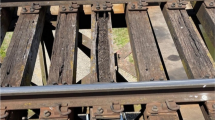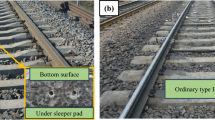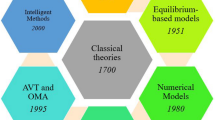Abstract
Bogies are one of the multifunctional parts of trains which are extremely subjected to random loads. This type of oscillating and random excitation arises from irregularities of the track including rail surface vertical roughness, rail joints, variance in super-elevation, and also wheel imperfections like wheel flats and unbalancy. Since most of the prementioned sources have random nature, a random based theory should be applied for fatigue life estimation of the bogie frame. Two methods of fatigue life estimation are investigated in this paper. The first approach which is being implemented in time domain is based on the damage accumulation (DA) approach. Using Monte-Carlo simulation algorithm, the rail surface roughness is generated. Finite element (FE) model of the bogie is subjected to the generated random excitation in the first approach and the stress time histories are obtained, and consequently the fatigue life is estimated by using the rain-flow algorithm. In the second approach, the fatigue life is estimated in frequency domain. Power spectral density (PSD) of the stress is obtained by using the FE model of the bogie frame and the fatigue life is estimated using Rayleigh technique in random fatigue theory. A comprehensive parametric study is carried out and effects of different parameters like the train speeds and level of the rail surface vertical roughness on the estimated fatigue life are investigated.
Similar content being viewed by others
References
N.-P. Kim, Experimental study on the fatigue strength of the bogie frame for tilting railway vehicles, Key Engineering Materials, 321/323 (2006) 590–593.
B. H. Park, Bogie frame design in consideration of fatigue strength and weight reduction, Journal of Rail and Rapid Transit, 220(3) (2006) 201–206.
J.-S. Bang, An automation of fatigue durability analysis for welded bogie frame using multi-agent based engineering framework, WSEAS Transactions on Information Science and Applications, 3(12) (2006) 2367–2373.
J.-S. Kim and N. P. Kim, Structural assessment for bogie frame of 180km/h Korean tilting train, Key Engineering Materials, 297/300 (2005) 345–350.
S.-H. Han, Process integration of fatigue analysis for welded bogie frames, Key Engineering Materials, 321–323 (2006) 624–627.
S. Dietz, H. Netter and D. Sachau, Fatigue life prediction of a railway bogie under dynamic loads through simulation, Vehicle System Dynamics, 29(6) (1998) 385–402.
J. S. Kim, Fatigue assessment of tilting bogie frame for Korean tilting train: Analysis and static tests, Engineering Failure Analysis, 13(8) (2005) 1326–1337.
S. Iwnicki, Handbook of Railway Vehicle Dynamics, CRC Taylor and Francis Publishers, New York, USA, (2007).
A. A. Lari, D. Younesian and F. Schmid, Tangential force variation due to the bogie direction reversal procedure, Vehicle System Dynamics, 45(4) (2007) 359–373.
L. D. Lutes and S. Sarkani, Stochastic Analysis of Structural and Mechanical Vibrations, Prentice Hall, New Jersey, USA, (1997).
D. Younesian, M. H. Kargarnovin, D. J. Thompson and C. J. C. Jones, Ride Comfort of High Speed Train Traveling over Railway Bridges, Vehicle System Dynamics, 43(3) (2005) 173–197.
Y. S. Wu and Y. B. Yang, Steady-state response and riding comfort of trains moving over a series of simply supported bridges, Engineering Structures, 25 (2003) 251–265.
On-Track Measurement in Iran with MD523 and MD36, Technical Report, Provided by Bombardier Transportation GmbH, RAJA, Passenger Trains Co, Iran (2006).
M. Ansari, D. Younesian and E. Esmailzadeh, Longitudinal Dynamics of Freight Trains, International Journal of Heavy Vehicle Systems, 1/2 (2009) 101–132.
Author information
Authors and Affiliations
Corresponding author
Additional information
This paper was recommended for publication in revised form by Associate Editor Hong Hee Yoo
Davood Younesian received his MSc and PhD in Mechanical Engineering, both from Sharif University of Technology, Iran. He joined the Iran University of Science and Technology in 2005 as an Assistant Professor in the School of Railway Engineering. Dr Younesian’s research area is mainly focused on non-linear and random vibrations, optimal control of vibrations, dynamics and vibration of structures and railway vehicle systems. He has published more than 75 papers in international journals and conference proceedings in the areas of his research.
Ali Solhmirzaei received his BSc in Railway Engineering (Rolling Stock) from Iran University of Science and Technology and his MSc in Mechanical Engineering from K.N.T University of Technology, Iran. His research is mainly focused on finite elements, railway vehicle dynamics and fatigue analysis of railway structures.
Alireza Gachloo received his BSc in Railway Engineering (Rolling Stock) from Iran University of Science and Technology, Iran. His research is mainly focused on random vibration, railway vehicle dynamics and random fatigue.
Rights and permissions
About this article
Cite this article
Younesian, D., Solhmirzaei, A. & Gachloo, A. Fatigue life estimation of MD36 and MD523 bogies based on damage accumulation and random fatigue theory. J Mech Sci Technol 23, 2149–2156 (2009). https://doi.org/10.1007/s12206-009-0622-y
Received:
Revised:
Accepted:
Published:
Issue Date:
DOI: https://doi.org/10.1007/s12206-009-0622-y




